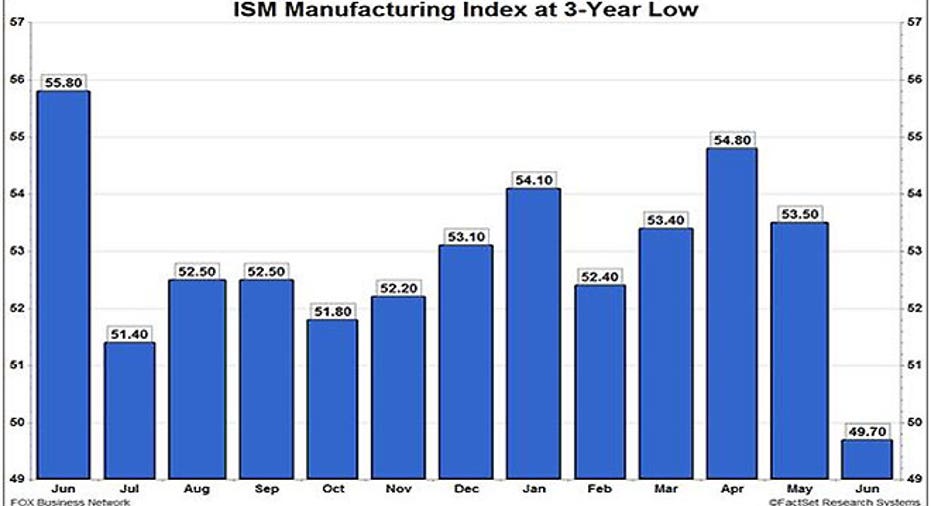Recession Odds Grow After Dreary ISM Report

A closely-watched economic gauge revealed on Monday that the U.S. manufacturing sector dipped into contraction territory in June for the first time in nearly three years, once again setting off alarm bells that the nation could be teetering back towards recession.
The surprisingly gloomy Institute for Supply Management index is the latest piece of evidence showing the U.S. economy is slowing down amid jitters about the eurozone debt debacle, China’s slowdown and lingering policy uncertainties at home.
The index plummeted to 49.7 in June, badly missing forecasts for 52 and marking the first sub-50 reading since July 2009 when the U.S. economy was emerging from the Great Recession.
"This is not good. Not good at all,” Dan Greenhaus, chief global strategist at BTIG, wrote in a note. “The ISM Manufacturing Index remains a premier economic indicator and a reading below 50 in June is incredibly, incredibly worrisome.”
Recession Looming?
Besides the headline drop below the crucial 50 level, economists were alarmed by a plunge in the new orders component of the index to 47.8 from a 13-month high of 60.1 in May.
According to John Ryding, chief economist at RDQ Economics, the decline in the new orders index was one of the three largest in the past 32 years. It nearly matched a tumble seen in new orders in October 2001 in the aftermath of the Sept. 11 terrorist attacks.
“It fell back to earth with a really big clunk,” said Ryding. He said it’s not yet clear whether last month’s decline was in response to a May reading that was out of whack or if it signals greater trouble.
The U.S. joins a slew of other countries that have recently slipped into contraction territory on the manufacturing front, including Brazil, the U.K., Australia, New Zealand and South Africa. Most of the eurozone is also in contraction mode, including economic heavyweights France, Germany, Spain and the Netherlands.
The dreary ISM report, combined with the global weakness and other gloomy indicators, appears to have increased the chances of a recession in the U.S.
Adolfo Laurenti, senior economist at Mesirow Financial, said he believes the odds of a recession have climbed to 25% after the ISM report, up from 15% earlier.
“Investors have to begin, at a minimum, considering the possibility” that the U.S. could succumb to a double-dip recession in the second half of the year, said Greenhaus.
'Seen This Story Before'
However, few economists are outright calling for a recession, with most forecasting a continuation of the lackluster growth that has been a hallmark of the recovery that began in March 2009.
“This is not a done deal yet,” said Laurenti. “We still have plenty of chances to escape this outcome, but clearly we are getting in a tough spot where the risks are increasing.”
While it fits in the general slowdown theme of recent months, it’s possible the June ISM report was an aberration, painting a darker picture than reality.
“These numbers do bounce around and you don’t want to hang your hat on any one number or get bent out of shape about a magic level,” said Josh Feinman, global chief economist at Deutsche Bank’s (NYSE:DB) DB Advisors. Feinman puts the chances of a recession at about 20%, up significantly from months earlier.
It’s also not exactly groundbreaking for economists and investors to be holding a double-dip debate at this time of the year. After all, the U.S. suffered scary slowdowns in each of the past two years that ultimately failed to send the economy into the red.
“We’ve seen this story before in this recovery,” said Feinman. “One of the lessons we’ve learned is don’t extrapolate short-term trends too far, on the upside or downside.”
Subject to Downdrafts
The constant threat of a short-term shock sending the economy into reverse underscores the sluggish nature of the recovery due in part to a continued hangover from the worst financial crisis since the Great Depression.
A more robust recovery that produced gross domestic product growth of 4% to 5% would be able to withstand these obstacles without a constant recession debate.
Ryding compared it with hitting an air pocket that causes a plane to drop a few hundred feet. If the plane is flying at a healthy 35,000 feet, “it may churn your stomach” but not put the plane itself at risk.
“If you’re in an economic equivalent of flying not that high above the treetops, then you do worry about that downdraft,” said Ryding.
In addition to the hangover from the Great Recession, the U.S. economy is suffering from an inordinate amount of policy uncertainty on everything from the looming fiscal cliff and the health-care reform to the 2012 election.
“When you don’t know what the tax rates on your business are going to be in six months time that starts to have an impact on the economy today,” said Ryding.
On the Upside
Economists see a few silver linings from the dismal June ISM report and the slowdown more broadly.
For example, the employment index in the ISM report dipped only slightly, to 56.6 from 56.9 in May.
“Manufacturers do not see the weakness in foreign orders as causing a deep enough slowdown to merit cutting employees,” Barclays (NYSE:BCS) noted.
Feinman said the slowdown jitters could wake up politicians over the need to get clarity on taxes and spending.
“It may worry policymakers enough in Washington that they avert the fiscal cliff,” said Feinman.



















